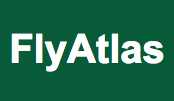Status:
Platform:
Implement Technique:
Species:
FlyAtlas 2 ( www.flyatlas2.org ) is part successor, part complement to the FlyAtlas database and web application for studying the expression of the genes of Drosophila melanogaster in different tissues of adults and larvae. Although generated in the same lab with the same fly line raised on the same diet as FlyAtlas, the FlyAtlas2 resource employs a completely new set of expression data based on RNA-Seq, rather than microarray analysis, and so it allows the user to obtain information for the expression of different transcripts of a gene. Furthermore, the data for somatic tissues are now available for both male and female adult flies, allowing studies of sexual dimorphism. Gene coverage has been extended by the inclusion of microRNAs and many of the RNA genes included in Release 6 of the Drosophila reference genome. The web interface has been modified to accommodate the extra data, but at the same time has been adapted for viewing on small mobile devices. Users also have access to the RNA-Seq reads displayed alongside the annotated Drosophila genome in the (external) UCSC browser, and are able to link out to the previous FlyAtlas resource to compare the data obtained by RNA-Seq with that obtained using microarrays.[1]
The FlyAtlas resource contains data on the expression of the genes of Drosophila melanogaster in different tissues (currently 25-17 adult and 8 larval) obtained by hybridization of messenger RNA to Affymetrix Drosophila Genome 2 microarrays. The microarray probe sets cover 13,250 Drosophila genes, detecting 12,533 in an unambiguous manner. The data underlying the original web application (http://flyatlas.org) have been restructured into a relational database and a Java servlet written to provide a new web interface, FlyAtlas 2 (http://flyatlas.gla.ac.uk/), which allows several additional queries. Users can retrieve data for individual genes or for groups of genes belonging to the same or related ontological categories. Assistance in selecting valid search terms is provided by an Ajax 'autosuggest' facility that polls the database as the user types. Searches can also focus on particular tissues, and data can be retrieved for the most highly expressed genes, for genes of a particular category with above-average expression or for genes with the greatest difference in expression between the larval and adult stages. A novel facility allows the database to be queried with a specific gene to find other genes with a similar pattern of expression across the different tissues.[2]
References
- FlyAtlas 2: a new version of the Drosophila melanogaster expression atlas with RNA-Seq, miRNA-Seq and sex-specific data.,
, Nucleic Acids Res, 2017 Oct 24, (2017)
- FlyAtlas: database of gene expression in the tissues of Drosophila melanogaster.,
, Nucleic Acids Res, 2013 Jan, Volume 41, Issue Database issue, p.D744-50, (2013)








